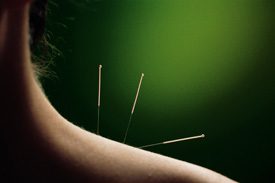Call us on
Menu
Menu
During the past decades, worldwide clinical and scientific interest in dry needling (DN) therapy has grown exponentially. Unlike acupuncture, dry needling is not based on the flow of chi or traditional Chinese medicine. Dry needling is based on a thorough understanding of the scientific background of trigger points.
From a pain science perspective, trigger points are constant sources of peripheral nociceptive input leading to peripheral and central sensitization.
Dry needling can:
Dry needling is a skillful therapy that uses a thin, filiform needle to penetrate the skin and stimulate underlying muscular trigger points or muscular and connective tissues for the management of neuromusculoskeletal pain and movement problems.
Dry needling does a great job of deactivating muscular trigger points. These are tender knots in a muscle that can refer pain to distant body areas. For example, someone with pain radiating down the thigh to the ankle may have a trigger point at the side of their hip that is only painful to deep palpation. The brief insertion of a needle into this trigger point results in a twitch of the muscle, immediate relaxation of the trigger point, and subsequent reduction of radiating symptoms to the leg.
Like any therapy that has an effect, there is a possibility of unintended side effects. It is important to have a discussion about the benefits, risks, and other treatment alternatives for any type of treatment. With regards to dry needling, up to 10% of people may experience needling insertion pain, muscle soreness, fatigue or bruising.
The staff at Wholistic Health Centre are skilled dry needling therapists and consider dry needling to be a relatively safe and very effective treatment that follows a careful examination and diagnosis.
 Nerve, muscle and joint pain are often a merely a sign of a movement problem. Dry needling, performed in conjunction with other manual and rehabilitative therapies such as chiropractic care, may be an excellent way to improve range of motion and decrease muscle or tendon pain.
Nerve, muscle and joint pain are often a merely a sign of a movement problem. Dry needling, performed in conjunction with other manual and rehabilitative therapies such as chiropractic care, may be an excellent way to improve range of motion and decrease muscle or tendon pain.
Dry needling can assist in treatment of:
This is why we may incorporate dry needling into a patient’s treatment plan at Wholistic Health Centre.
References:
Dry needling peripheral and central considerations
Journal of Manual & Manipulative Therapy, November 2011, Vol.19(4), pp.223-227 [Peer Reviewed Journal]
Physiologic Effects of Dry Needling
Current Pain and Headache Reports, 2013, Vol.17(8), pp.1-8 [Peer Reviewed Journal]
If you would like more information about dry needling at our Wolli Creek location or Kareela office, or information about integrating dry needling with other physical therapy and rehabilitation techniques for movement related pain, please do not hesitate to contact us on (02) 9599-6554.
7:30 am - 7:00 pm
8:00 am - 7:00 pm
8:00 am - 8:00 pm
7:30 am - 8:00 pm
7:30 am - 8:00 pm
8:00 am - 8:00 pm
10:00 am - 7:00 pm
10:00 am - 7:00 pm
12:00 pm - 7:00 pm
8:00 am - 5:00 pm
8:00 am - 1:00 pm